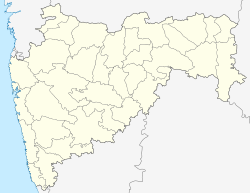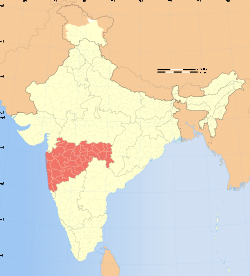Nagpur
| Nagpur (नागपूर) | |
| Orange city | |
| — 2nd capital of Maharastra — | |
|
|
|
| Coordinates | |
| Country | |
| Region | Vidarbha |
| State | Maharashtra |
| District(s) | Nagpur |
| Founded | 1702 A.D
[5]</ref> |
| Mayor | Archana Dehankar |
| Municipal Commissioner | Sanjeev Jaiswal[1] |
| Population • Density |
2,420,000[2] (2006[update]) • 11,101 /km2 (28,751 /sq mi) |
| Official languages | Marathi |
|---|---|
| Time zone | IST (UTC+5:30) |
| Area |
218 km2 (84 sq mi) • 310 metres (1,020 ft) |
| Website | www.nagpur.nic.in |
 |
|
Nāgpur pronunciation (Marathi: नागपूर) is a city in the state of Maharashtra, the largest city in the central India and the third largest city by population in the state of Maharashtra. With a population of around 2,420,000; Nagpur UA is the 13th largest urban conglomeration in India[3], the 114th largest city [2] in world, and the 143rd largest urban area in world in terms of population.[4] The city is the seat of annual winter session of Maharashtra state assembly "Vidhan Sabha". Nagpur is the major commercial and political center of the backward Vidarbha region of Maharashtra, and is famous throughout the country as "Orange City" for being a major trade center of oranges.[5] The city derives political importance from being the headquarters for the Hindu nationalist organisation RSS and an important location for the Dalit Buddhist movement.
Nagpur lies precisely at the center of the country with the Zero Mile Marker (indicating the geographical center of India) located here.[6] The city was founded by the Gonds but later became part of the Maratha Empire under the Bhonsles. The British East India Company took over Nagpur in the 19th century and made it the capital of the Central Provinces and Berar. After the first reorganization of states, the city lost its capital status but according to the informal "Nagpur Pact" between political leaders it was made the second capital of Maharashtra.
Contents |
Etymology
The Nag River, a tributary of the Kanhan River, flows in a serpentine path and so is named, "Nag", the Marathi word for Cobra. Nagpanchami, a religious day on which people worship/show respect to snake by providing milk as a food, is observed by the majority of the people. According to Dr. B. R. Ambedkar people of Nagpur belong to nag dynasty who were followers of the Buddha. And, so the river and city is named as Nagpur. While others says that the river flows through the old city of Nagpur and hence the city is named after this river. "Pur" is common suffix given to cities, villages and towns across India, and is often simply translated "city".[7] The seal of Nagpur Municipal Corporation depicts a cobra in the water of a river.
History
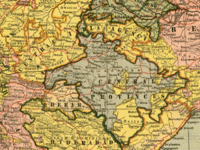
Human existence around present day Nagpur city can be traced back 3000 years to 8th century BC. Mehir burial sites at Drugdhamna (near Mhada colony) indicate megalithic culture existed around Nagpur and is still followed in present times[8]. The first reference to the name Nagpur is found in a 10th century copper-plate inscription discovered at Devali in the neighbouring Wardha district. The inscription is a record of grant of a village situated in the visaya (district) of Nagpura-Nandivardhana during time of Rastrakuta king Krsna III in the Saka year 862 (940 CE).[9] Towards the end of third century King Vindhyasakti is known to have ruled the Nagpur region. In the 4th century Vakataka Dynasty ruled over the Nagpur region and surrounding areas and had good relations with the Gupta Empire. The Vakataka king Prithvisena I moved his capital to Nagardhan (ancient name Nandivardhana), located at 28 kilometers (17 mi) from Nagpur.[10]
Recent history ascribes the founding of Nagpur to Bakht Buland, a prince of the Gond kingdom of Deogarh in the Chhindwara district.The next Raja of Deogarh was Chand Sultan,' who resideu principally in the country below the hills, fixing his capital at Nagpur which he made a walled town. He continued the liberal policy of his predecessor and under him the wealth of the country so increased as to make it a desirable acquisition to the great predatory Maratha power already established in Berar. On Chand Sultan's death in 1739, Wali Shah, an illegitimate son of Bakht Buland, usurped the throne and Chand Sultan's widow invoked the aid of Raghuji Bhonsla of Berar in the interest of her sons Akbar Shah and Burhan Shah. The usurper was put to death and the rightful heirs placed on the throne. Raghuji retired to Berar, having concluded a treaty with them by which he received eleven lakhs of rupees and several Districts on the Wainganga as the price of his assistance, and was appointed the organ of all communications between the Gonds and the Government of Satara.
This was the first direct connection of the Bhonsla family with Nagpur, although part of Gondwana had been conquered by Kanhoji Bhonsla as early as 1716. But the country was not destined to remain long without Raghuji's interference. Dissensions between the brothers ripened into civil war. In the year 1742, on one occasion, 12,000 Gonds are said to have been massacred in the fort of Patansaongi. In the following year (1743) Raghuji was called in to support the elder brother Burhan Shah. Akbar Shah was driven into exile and finally poisoned at Hyderabad. Raghuji had not the heart to give back to the weaker Gond a second time the country he held within his grasp. He constituted himself Protector, took all real power into his own hands, and making Nagpur his capital, quickly reduced all Deogarh to his own authority. But still he studiously preserved the show of Burhan Shah's dignity; whilst in reality he reduced him to the condition of a dependent, having a fixed share of the revenue, and the empty title of Raja. Burhan Shah's descendants have continued to occupy the position of state pensioners to the present time, and the representative of the family resides at Nagpur with the title of Raja being called Sansthanik. The founder of the Bhonsla family was Mudhoji Patel of Deor, in the Satara District, from which place the present representative of the family derives his title of Raja. The correct spelling of the family name is Bhosle and it is derived from Bhosa, a village near Bombay. Mudhoji is said to have been a Silladar or leader of horse under the great Sivaji, and of his 3 sons- Bapuji, Parsoji and Sabaji-Parsoji rendered distinguished military service in the early Maratha wars, and as a reward was entrusted with the right to collect Chauth [The fourth of the revenue claimed by the Marathas.] in Berar. He died in 1709 and was succeeded by his son Kanhoji who was soon displaced by his cousin Raghuji, a grandson of Mudhoji's second son Bapuji. Raghuji was the first and most distinguished of the Bhonsla rulers of Nagpur. He had plundered the country from Berar up to the gates of Allahabad. In 1740 he made a raid on the Carnatic, and immediately afterwards commenced a series of expeditions to Bengal, which terminated after a contest of ten years in the acquisition to the Marathas of Cuttack and the promise of twelve lakhs annually from Ali Vardi Khan as the Chauth of Bengal. In the meantime Raghuji established himself in Nagpur, where he reigned nominally as the representative of the Gond prince from 1743 to 1755. By 1751 he had effected the conquest of the Deogarh territories, Chanda and Chhattisgarh. Ratanpur, the capital of the Haihayavansi kingdom, capitulated without a blow in 1741 on the advance of the Maratha General, Bhaskar Pant, and four years afterwards, with the deposition of the last Raja, a Rajput dynasty whose annals carried it back to the commencement of the Christian era, ignominiously ended. The fort of Chanda was delivered up to Raghuji by the treachery of a Diwan in 1749 and two years later was finally ceded to him Raghuji died in 1755. The countries under his dominion or paying him tribute may be generally described as extending east and west from the Bay of Bengal to the Ajanta hills and north and south from the Nerbudda to the Godavari. His army was principally composed of horse. His standing force was about 15,000, but was liable to be augmented every year according to the exigencies of the moment. Bold and decisive in action Raghuji was the perfect type of a Maratha leader. He saw in the troubles of others only an opening for his own ambition and did not even require a pretext for plunder and invasion. The reign of Raghuji I. is chiefly important in the history of Nagpur because with him came that great influx of the Kunbis and cognate Maratha tribes which altered the whole face of the country and the administration of the land, as well as the language of the people.
In 1743, the Maratha leader Raghoji Bhonsle of Vidarbha established himself at Nagpur, after conquering the territories of Deogarh, Chanda and Chhattisgarh by 1751. After Raghoji's death in 1755, his son and successor Janoji was forced to acknowledge the effective supremacy of the Maratha Peshwa of Pune in 1769. Regardless of the military conquests, the Nagpur state continued to grow. Janoji's successor Mudhoji I (d. 1788) came to power in 1785 and bought Mandla and the upper Narmada valley from the Peshwa between 1796 and 1798, after which Raghoji II (d. 1816) acquired Hoshangabad, the larger part of Saugor and Damoh. Under Raghoji II, Nagpur covered what is now the east of Maharashtra, Chhattisgarh, Orissa, and parts of Madhya Pradesh and Jharkhand.
In 1803 Raghoji II joined the Peshwas against the British in the Second Anglo-Maratha War. The British prevailed, and Raghoji was forced to cede Cuttack, Sambalpur, and a part of Berar. After Raghoji II's death in 1816, his son Parsaji was deposed and murdered by Mudhoji II. Despite the fact that he had entered into a treaty with the British in the same year, Mudhoji joined the Peshwa in the Third Anglo-Maratha War in 1817 against the British, but was forced to cede the rest of Berar to the Nizam of Hyderabad, and parts of Saugor and Damoh, Mandla, Betul, Seoni and the Narmada valley to the British after suffering a defeat at Sitabuldi in modern-day Nagpur city. The Sitabuldi fort was the site of a fierce battle between the British and the Bhonsle of Nagpur in 1817. The battle was a turning point as it laid the foundations of the downfall of the Bhonsles and paved the way for the British acquisition of Nagpur city.[11]
Mudhoji was deposed after a temporary restoration to the throne, after which the British placed Raghoji III the grandchild of Raghoji II, on the throne. During the rule of Raghoji III (which lasted till 1840), the region was administered by a British resident. In 1853, the British took control of Nagpur after Raghoji III died without leaving an heir.
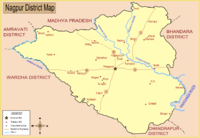
From 1853 to 1861, the Nagpur Province (which consisted of the present Nagpur region, Chhindwara, and Chhatisgarh) became part of the Central Provinces and Berar and came under the administration of a commissioner under the British central government, with Nagpur as its capital. Berar was added in 1903. Tata group started the country's first textile mill at Nagpur[12], formally known as Central India Spinning and Weaving Company Ltd. The company was popularly known as "Empress Mills" as it was inaugurated on 1 January 1877, the day queen Victoria was proclaimed Empress of India. Tata was inclined towards locating the steel plant around the Nagpur region, which too had iron ore deposits. It was Boses 1904 letter that finally resulted in J N Tata deciding in favour of Mayurbhanj instead of the Nagpur belt. Bose was then serving as a state geologist to the Maharaja of Mayurbhanj, having stepped down from the Geological Survey of India (GSI) for having been bypassed for the topmost post in the organization. [13], who in 1925 founded the RSS, a Hindu nationalist organization in Nagpur with an idea of creating a Hindu nation. After the 1927 Nagpur riots RSS gained further popularity in Nagpur and the organization grew nationwide.
After Indian Independence in 1947, Central Provinces and Berar became a province of India, and in 1950 became the Indian state of Madhya Pradesh, again with Nagpur as its capital. However when the Indian states were reorganized along linguistic lines in 1956, the Nagpur region and Berar were transferred to Bombay state, which in 1960 was split between the states of Maharashtra and Gujarat. At a formal public ceremony on October 14, 1956 in Nagpur B. R. Ambedkar along with his supporters converted to Buddhism starting Dalit Buddhist movement which is still active. In 1994, the city witnessed its most violent day in modern times in form of Gowari stampede deaths.
Nagpur has completed 300 years of establishment in the year 2002. A big celebration was organized to mark the event.
Also see: Nagpur state
Geography and climate
| Nagpur | ||||||||||||||||||||||||||||||||||||||||||||||||||||||||||||
|---|---|---|---|---|---|---|---|---|---|---|---|---|---|---|---|---|---|---|---|---|---|---|---|---|---|---|---|---|---|---|---|---|---|---|---|---|---|---|---|---|---|---|---|---|---|---|---|---|---|---|---|---|---|---|---|---|---|---|---|---|
| Climate chart () | ||||||||||||||||||||||||||||||||||||||||||||||||||||||||||||
|
||||||||||||||||||||||||||||||||||||||||||||||||||||||||||||
|
||||||||||||||||||||||||||||||||||||||||||||||||||||||||||||
Geography
Nagpur lies on the Deccan plateau of the Indian Peninsula and has a mean altitude of 310 meters above sea level.[14] The underlying rock strata is covered with alluvial deposits resulting from the flood plain of the Kanhan River. In some places these give rise to granular sandy soil. In low lying areas which are poorly drained, the soil is alluvial clay with poor permeability characteristics. In the eastern part of city crystalline metamorphic rocks such as gneiss, schist and granites are found, while in the northern part yellowish sand stones and clays of the lower Gondwana formations are found. [15]
Nagpur city is dotted with natural and man-made lakes with Ambazari lake being the largest. Other natural lakes include Gorewada Lake and Telangkhedi lake. Sonegaon lake along with Gandhisagar lake are man-made lakes created by cities historical rulers. Nag river, Pilli nadi along with nallas form the natural drainage pattern for the city.[16] [17] Nagpur is known for its greenery, and was judged as the cleanest and second greenest in India after Chandigarh.[18]
Climate
As it is located at centre of Indian peninsula far from Bay of Bengal and Arabian sea, Nagpur has a tropical wet and dry climate with dry conditions prevailing for most of the year . Nagpur city receives an annual rainfall of 1,205 mm (47.44 in) from monsoon rains during June to September.[19] The highest recorded rainfall was 304 mm on July 14, 1994.[20] Summers are extremely hot lasting from March to June, with maximum temperatures occurring in May. Winter lasts from November to January, during which temperatures can drop below 10°C (50°F).[14] The highest recorded temperature in the city was 48.6 °C (119.5 °F) on 26 May 1954,[21] while the lowest was 3 °C.
Civic administration
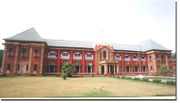
Nagpur is administered by Nagpur Municipal Corporation (NMC) which is democratically elected civic governing body. Nagpur Improvement Trust (NIT) works with NMC and carries out works like development of the civic infrastructure and new urban areas on behalf of NMC.[22] The city is divided in 10 zones which are in turn divided into 136 wards.[23] Each ward is represented by a corporator, majority of whom are elected in local elections.
Industry
Nagpur is headquarters of national level scientific and governmental establishments like the National Environmental Engineering Research Institute NEERI, the Central Institute of Cotton Research (CICR), the National Research Centre for Citrus, the National Bureau of Soil Survey and Land Use Planning, the Jawaharlal Nehru National Aluminium Research and Development Centre, and the Petroleum And Explosives Safety Organisation (PESO) (formerly known as Department of Explosives).
Military
Nagpur is an important city for the Indian armed forces. The city is the headquarters of Maintenance Command of Indian Air Force. The Indian Army's Ordinance factory and staff college are located on the west side of city. Nagpur's suburb Kamptee has cantonment of Regimental center of Indian Army's Brigade made up of National Cadet Corps' Officers' Training School, Institute of Military Law and other establishments. Nagpur's National Civil Defense College provides civil defense and disaster management training to pupils from all over India and abroad. Indian Air Force's giant IL-76 transport planes nicknamed "Gajraj" are based in Nagpur.[24]
Demographics
| Nagpur population | |||
|---|---|---|---|
| Census | Pop. | %± | |
| 1981 | 1,219,500 |
|
|
| 1991 | 1,664,000 | 36.4% | |
| 2001 | 2,321,200 | 39.5% | |
| Source: Census of India[25] | |||
Marathi, the official language of Maharashtra, is the local language in Nagpur. The Varhadi dialect of Marathi is spoken in and around Nagpur city. Urdu and Hindi are also spoken. Due to its central location Nagpur has become cosmopolitan with a large number of residents from neighboring states of Madhya Pradesh, Chattisgarh and Andhra Pradesh.
In 2001, the urban population was 2,129,500, and there were around 410,000 households in the city. 726,664 people lived in slums making Nagpur second-most slum-populated city in Maharashtra after Mumbai.[26] Scheduled Castes and Scheduled Tribes accounted for around 25% of the population.
The sex ratio was 936 females per 1000 males. Around 99.4% of the population was engaged in non-agricultural activities, attesting to the overwhelmingly urban character of Nagpur city.[27] According to 2006 survey of National Crime Record Bureau Nagpur has the highest crime rate of 470.6 in Maharashtra as compared to other mega-cities of the state.[28] The number of migrants to Nagpur from outside Maharashtra during the 1991-2001 decade was 2.1 lakh making Nagpur the fourth most favored destination in state.[29]
Education
Nagpur is a major education centre.[30]. The Nagpur university is now known as Rashtrasant Tukadoji Maharaj (R.T.M.) Nagpur University, Nagpur. The city has both municipal schools (run by the NMC) as well as private schools (run by trusts or individuals), which in some cases receive financial aid from the government. The city's school system follows a 10+2+3/4 plan, after which students have the option to enroll in Junior college and later degree courses. Founded in 1923, Nagpur University[31] is one of the oldest in the country[32] and has geographical jurisdiction over the five districts of Nagpur division in addition to giving affiliation to hundreds of colleges. Nagpur has one veterinary college Veterinary College [33], and three Medical colleges namely Government Medical College and Hospital (GMCH), Indira Gandhi Medical College (IGMC) and Lata Mangeshkar Medical College (LMC). Nagpur has several engineering colleges which provide education in various specialty courses. Visvesvaraya National Institute of Technology (VNIT) is one of the reputed technical institutes in the country and also an Institute of National Importance. Nagpur has India's only National Fire Service College that provides a graduation course in Fire Engineering[34]. The Raman Science Centre promotes scientific knowledge and has a 133 seat planetarium[35].
The well known colleges for higher education are VNIT and University Department Pharmaceutical Sciences (UDPS), Nagpur. Nagpur has several social work colleges, the oldest and most prominent among them is the Matru Sewa Sangh Institute of Social Work in Bajaj Nagar.
People and culture
The city contains people from other Indian states as well as people belonging to the world's major faiths. Nagpur plays host to cultural events throughout the year. Cultural and literary societies in Nagpur include Vidarbha Sahitya Sangh (for development of Marathi), Vidarbha Rashtrabhasha Prachar Samiti (promotion and spreading Hindi) and Vidarbha Hindi Sahitya Sammelan (for promoting Hindi).
Marathi Sahitya Sammelan, the conference on Marathi Literature were held twice in Nagpur city. They were presided by President of the Conference Krushnaji Prabhkar Khadilkar in 1933 and Arun Sadhu in 2007.
The Nagpur central museum (estb. 1863) maintains collections are mainly for Vidarbha region.[36] The South Central Cultural Centre also sponsors cultural events in Nagpur city, such as the Orange City Craft Mela and Folk Dance Festival, which is noted for its numerous folk-dances.[37] Newspapers are published from Nagpur in Marathi, English and Hindi. The Hitavada is one of the oldest English daily newspaper published in central India. Nagpur is known for staying calm during communal conflicts in India.[38]
The Vidarbha Cricket Association Ground (VCA) in Nagpur is one of the nine test venues in the country. A new stadium of VCA called Vidarbha Cricket Association Stadium has been built on Wardha road with a seating capacity of 45,000 people at cost of ![]() 75 crore (US$ 17.03 million).[39][40][41].
75 crore (US$ 17.03 million).[39][40][41].
INOX Wardhaman Nagar (area:45,000 square feet) is the first multiplex in city. Now days, city has 3 more multiplexes including Inox Jaswant Tuli Mall, Cinemax Sitabuldi & Sangam Adlabs Sakkardara. The present day Maharajbagh zoo was originally a garden developed by the Bhonsle rulers.[42]. The Government of Maharashtra has approved a new safari park of international standards besides Gorewada Lake.
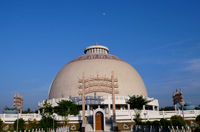
Deekshabhoomi, the largest hollow stupa and an important place of dalit buddhist movement, is located in Nagpur [43]. Every year on the day of Vijayadashmi i.e. Dasehara, followers of Ambedkar visit deekshabhoomi. The 14th April, which is birth date of Dr. B. R. Ambedkar is celebrated. The most famous Temple in Nagpur is Tekdi Ganesh Mandir, located near Nagpur Railway Station. It is one of the Swayambhu (means Self-Manifested) temple in city. Sri Poddareshwar Ram Mandir and Shri Mahalaxmi Devi temple of Koradi are important Hindu temples[44]. Religious events are observed in the city throughout the year. Ram Navami is celebrated in Nagpur with shobha yatra with a procession of floats depicting events from the Ramayana[45]. Processions are also held on important festivals of other religions such as Eid E Milad, Guru Nanak Jayanti, Mahavir Jayanti, Durga puja, Ganesh Puja and Moharram. Like the rest of India, Nagpurkars celebrate major Hindu festivals like Diwali, Holi and Dussera with enthusiasm. Celebrations lasting for several days are held on Ganesh Chaturthi and Durga Puja festivals in virtually every small locality in the city. The city also contains a sizable Muslim population, and famous places of worship for Muslims include the Jama Masjid-Mominpura and Bohri Jamatkhana-Itwari. In addition to annual religious festivals and processions, the Government of Maharashtra organizes a week long Kalidas Festival, a series of music and dance performances, by national level artists.[46]
Economy
Nagpur has been the main center of commerce in the Vidarbha region since early days and is an important trading location. However, Nagpur's economic importance had gradually declined relative to Mumbai and Pune after the merging of Vidarbha into the Maharashtra because of a period of neglect by the state government[47]. During the slowdown, state and central government offices were a major source of employment in the city. Nagpur's economy is now recovering from past slowdowns[48] and city has attracted Rupees 5,000 crore in investment in 2004.[49]. The city is important for the banking sector as it hosts the regional office of Reserve Bank of India, which was opened on September 10, 1956[50]. Sitabuldi market in central Nagpur, known as the Heart of the city, is the major commercial market area of city.
The Butibori industrial area is the largest in all of Asia in terms of area.[51] The estate's largest unit is of Indo Rama Synthetics, which manufactures synthetic polyester yarn. Other units in Butibori include the power transmission company KEC, Hyundai Unitech, ACC Nihon Castings Ltd.[52]. Koradi Thermal Power Station and Khaparkheda Thermal Power Station are the two major thermal power stations located near Nagpur and operated by MSPGCL.
The Hingna industrial estate located on the western fringes of the city is made up of around 900 small and medium industrial units. The major ones among them are tractor manufacturing plant of Mahindra and Mahindra, casting units of NECO Ltd. (the country's largest casting group),[53] units of International Combustions, Bajaj Auto group, Candico (the SECOND largest confectionery manufacturing plant in India [54]), Ajanta toothbrushes and Sanvijay Group (largest steel rolling group of companies for long products in Central India)[55]. Nagpur is home to ice-cream manufacturer Dinshaws, Indian dry food manufacturer Haldiram's and Ayurvedic product company Vicco [56].
Cargo hub and airport at Nagpur (MIHAN)
Nagpur is witnessing an economic boom as the "Multi-modal International Cargo Hub and Airport at Nagpur (MIHAN)" is being developed. MIHAN will be used for handling heavy cargo coming from south east Asia and the Middle East. The project will include ![]() 10,000 crore (US$ 2.27 billion) Special Economic Zone (SEZ)[57] for Information Technology (IT) companies. Persistent Systems has one of the software development centers at Nagpur.
10,000 crore (US$ 2.27 billion) Special Economic Zone (SEZ)[57] for Information Technology (IT) companies. Persistent Systems has one of the software development centers at Nagpur.
Transport
Rail
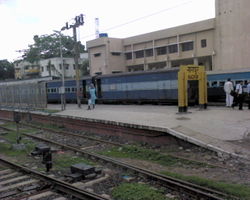
Due to its central location in India, the Nagpur Railway Station is an important railway junction and a transit terminal for trains that connect the country lengthwise and breadthwise, especially trains connecting India's major metropolises, Mumbai to Howrah-Kolkata, Delhi and Jammu to Chennai, Hydrabad, Bangalore and Kanyakumari in the South, as well as western cities such as Pune and Ahemedabad.[58] The city is the Divisional Head Quarters for the Central Railway and South East Central Railway Zone of Indian Railways.
Road
Nagpur is a major junction for roadways as India's two major national highways, Kanyakumari-Varanasi (NH 7) and Hajira-Kolkata (NH-6), passing through the city.[58] One more highway number 69 connect Nagpur to Obaidullaganj near Bhopal. Nagpur is at the junction of two Asian Highways namely AH43 Agra to Matara, Sri Lanka and AH46 connecting Kharagpur, India to Dhule, India. Auto rickshaws operate in most parts of Nagpur and are the main form of hired transport within the city. But unlike cities like Mumbai, Pune the tariff is not standardised.
The new national highway is being built between Nagpur and Mumbai, an alternative to the existing NH 6. This new Nagpur-Aurangabad-Mumbai express highway is build on the national highway basis, though being the state highway, entirely inside the state of Maharashtra. This highway will be a boost to the under developed regions of Vidarbha and Marathwada in Maharashtra state.
Air transport
Nagpur's Air Traffic Control (ATC) is the busiest in India,[58] with more than 300 international flights flying over the city every day in 2004.[59] In October 2005, Nagpur's Sonegaon Airport was declared an international airport and was renamed Dr. Babasaheb Ambedkar International Airport.[60] Country's first ever international cargo hub, the Multi-modal International Cargo Hub and Airport at Nagpur (MIHAN) is planned on the outskirts of the city.[61]
Food
Vidarbha region has its own distinctive cuisine known as the Varadi cuisine or Saoji Cuisine. Saoji food is traditional food of Nagpur, Maharashtra. The cuisine also called Saoji Waradi is famous for its spicy taste and is highly recommended to all the spicy food lovers. The special spices, which are used in making the gravy of Saoji food include black pepper, dry coriander, bay leaves, grey cardamom, cinnamon, cloves etc. Saoji Gravy is characterized by its spicy flavor and ample use of poppy seeds (Khus-Khus) and powdered coconut. Non-vegetarian food especially chicken and mutton are commonly used in Nagpur area for making the Saoji food, but vegetarian food can also be prepared especially using Boiled Potato, Paneer or Soya Chunks. Saoji food, although being very spicy, is not harmful to the body and does not lead to any digestive problems, as the process of cooking has been modified to overcome any health problems.
See also
- List of localities in Nagpur
- Deekshabhoomi
- Vidarbha
- Nagpur Division
- Maharashtra
- Vidarbha Cricket Association Stadium
- Visvesvaraya National Institute of Technology
References
- ↑ [1]
- ↑ 2.0 2.1 ""The world's largest cities"". City Mayors. http://www.citymayors.com/features/largest_cities_2.html. Retrieved 2006-06-26.
- ↑ ""Some 108 million people live in India's largest cities"". City Mayors. http://www.citymayors.com/gratis/indian_cities.html. Retrieved 2006-06.
- ↑ ""The world's largest cities and urban areas in 2006"". City Mayors. http://www.citymayors.com/statistics/urban_2006_2.html. Retrieved 2006-06-26.
- ↑ ""Stamps from the Orange City"". The Hindu. http://www.hindu.com/yw/2006/03/31/stories/2006033100200500.htm. Retrieved 2006-06-19.
- ↑ "Nagpur". Maharashtra Government. http://www.maharashtra.gov.in/marathi/mahInfo/nagpur.php. Retrieved 2006-06.
- ↑ "Nag River.". GAZETTEER DEPARTMENT OF GOVERNMENT OF MAHARASHTRA. http://www.maharashtra.gov.in/pdf/gazeetter_reprint/Nagpur/appendix_n.html#.. Retrieved 2008-05-20.
- ↑ "3000-year-old burial site unearthed". timesofindia.com. http://timesofindia.indiatimes.com/Cities/3000-year-old_burial_site_unearthed/rssarticleshow/2830035.cms. Retrieved 2008-03.
- ↑ "History of Nagpur District: Ancient Period". Maharashtra State Government Directorate of Government Printing, Stationery and Publications. http://www.maharashtra.gov.in/english/gazetteer/FINAL_GAZETTEE/history.html. Retrieved 2006-07-28.
- ↑ Ancient Indian History and Civilization. New Age International. 1999. pp. 242–248. ISBN 9788122411980. http://books.google.com/books?id=Wk4_ICH_g1EC&pg=PA242&dq=nagpur+district+administration&lr=&as_brr=3#PPA243,M1.
- ↑ ""The Battle of Sitabuldi"". Nagpurcity.net. http://www.nagpurcity.net/netzine/981215a2.html. Retrieved 2006-06.
- ↑ ""Are Indians Really Dumb?"". Rediff.com. http://www.rediff.com/money/2004/aug/10das.htm. Retrieved 2006-06.
- ↑ Gandhi in His Time and Ours. Orient Blackswan. 2003. pp. 165–166. ISBN 9788178241142. http://books.google.com/books?id=qvvgOvby58YC&pg=PA165&dq=nagpur+riots+of+1923&lr=&as_brr=3.
- ↑ 14.0 14.1 "Climatic Parameters of Nagpur". India Meteorological Department Regional Meteorological Centre, Nagpur. http://www.imdngp.org/cfnagpur.htm. Retrieved 2006-07-04.
- ↑ [2]
- ↑ [3]
- ↑ [4]
- ↑ "Nagpur". MSN Grren. http://green.in.msn.com/greenliving/article.aspx?cp-documentid=3490719&page=3. Retrieved 2010-01-28.
- ↑ "Geographical Information (on Nagpur city)". National Informatics Centre, Nagpur. http://nagpur.nic.in/htmldocs/GEO.htm. Retrieved 2006-06-30.
- ↑ ""Flooding, power cuts after Nagpur rains"". www.dnaindia.com. http://www.dnaindia.com/report.asp?NewsID=1042519. Retrieved 2006-07-18.
- ↑ Nagpur sizzles at 47.6 deg C, TNN, Times of India (Bombay), pg 1, 23 May 2005
- ↑ "About us". nitnagpur.org. http://nitnagpur.org/home.html. Retrieved 2008-06-23.
- ↑ "WARD DETAILS". www.nmcele.com. http://www.nmcele.com/ZoneMenu.asp?LinkId=2. Retrieved 2008-06-23.
- ↑ ""Orange booms: Big dreams come true in small town"". Daily News and Analysis India. http://www.dnaindia.com/dnaPrint.asp?NewsID=1000624&CatID=2. Retrieved 2006-08-17.
- ↑ "TABLE 7.2.11". mospi.gov.in. http://mospi.gov.in/comenv2000tab7.2.11.htm. Retrieved 2008-06-23.
- ↑ "UA demographics" (PDF). Census of India. www.planningcommission.nic.in. pp. 292. http://www.planningcommission.nic.in/plans/stateplan/sdr_maha/ch-13-14-02-05.pdf. Retrieved 2008-06-07.
- ↑ "Area Profile: Nagpur (urban)" (PDF). National Informatics Centre, Nagpur. http://nagpur.nic.in/census/area-pro-nagpur-mcorp-2001.pdf. Retrieved 2006-06-28.
- ↑ National Crime Records Bureau (2004). "Crimes in Mega Cities" (PDF Format). Crime in India-2004. Ministry of Home Affairs. http://ncrb.nic.in/crime2004/cii-2004/CHAP2.pdf. Retrieved 2006-05-23.
- ↑ "HIGHLIGHTS OF ECONOMIC SURVEY OF MAHARASHTRA 2005-06" (PDF). DIRECTORATE OF ECONOMICS & STATISTICS, PLANNING DEPARTMENT, GOVERNMENT OF MAHARASHTRA, MUMBAI. http://maccia.org.in/ecoSmaha06.pdf. Retrieved 2008-02-13.
- ↑ ""For some, small is beautiful"". Bussinessworld Magazine. http://www.businessworldindia.com/nov0104/news11.asp. Retrieved 2006-08-12.
- ↑ "History of Nagpur university". Nagpur University. http://www.nagpuruniversity.org/about%20us.htm. Retrieved 2006-06.
- ↑ "Nagpur University". Rajiv Gandhi College of Engineering, Research, and Technology website. http://www.rcert.ac.in/nag-uni.htm. Retrieved 2006-08-12.
- ↑ http://www.mafsu.in/nagpur/nagpur_main.html
- ↑ "Introduction: National Fire Service College, Nagpur". National Fire Service College, Nagpur. http://nfscnagpur.nic.in/. Retrieved 2006-06-28.
- ↑ "planetarium". ncsm.gov.in. http://ncsm.gov.in/exibits_6.aspx. Retrieved 2008-06-06.
- ↑ Nagpur District Gazetteer
- ↑ "Major Programs during the year". The South Central Cultural Zone. http://sczccnagpur.nic.in/majorprograms.htm. Retrieved 2006-06.
- ↑ ""Celebrating a unique city"". The Tribune. http://www.tribuneindia.com/2002/20020317/spectrum/main5.htm. Retrieved 2006-06.
- ↑ "Nagpur's new stadium ready to debut". Rediff. November 4, 2008. http://search.rediff.com/cricket/2008/nov/04nagpur.htm. Retrieved 2008-11-06.
- ↑ "Vidarbha Cricket Association Ground in Nagpur". Cricinfo.com. http://content-usa.cricinfo.com/india/content/ground/58344.html. Retrieved 2006-06-21.
- ↑ "One day Internationals, Vidarbha Cricket Ground". National Rugby League of Australia. http://stats.rleague.com/odi/venues/66.html. Retrieved 2006-06-22.
- ↑ "Maharaj Baug and Zoo". India9.com. http://www.india9.com/i9show/39427.htm. Retrieved 2006-06.
- ↑ ""Celebrating a unique city"". The Tribune. http://www.tribuneindia.com/2002/20020317/spectrum/main5.htm. Retrieved 2006-06.
- ↑ "Maharashtra Tourism mention about Koradi". Maharashtra Tourism. http://www.maharashtratourism.gov.in/Default.aspx?strpage=Nagpur_Koradi.html. Retrieved 2006-08-10.
- ↑ "About Shobha Yatra". Sri Poddareshwar Ram Mandir Website. http://www.poddareshwarrammandir.com/ShobhaYatra.html. Retrieved 2006-06.
- ↑ "The Kalidas Festival". Maharashtra Tourism Development Corporation. http://www.maharashtratourism.gov.in/Default.aspx?strpage=Kalidas_Festival.html. Retrieved 2006-06.
- ↑ "Economic Overview Of Nagpur". travelspedia.com. December 31, 2007. http://travelspedia.com/news/South-Asia/India/Maharashtra/Nagpur/Economic-Overview-Of-Nagpur.html. Retrieved 2008-07-03.
- ↑ Nagpur Economy and Industry - Nagpur Economic Boom
- ↑ ""Bangalore top investment destination"". Rediff.com. http://www.rediff.com/money/2003/jun/13investment.htm. Retrieved 2006-07-04.
- ↑ Reserve Bank of India
- ↑ ""Industrial fuel petrol from plastic waste: A success story"". The Daily Excelsior. http://www.dailyexcelsior.com/web1/05apr30/busi.htm. Retrieved 2006-06.
- ↑ "MIDC page on Butibori Industrial Area". Maharashtra Industrial Development Corporation (MIDC). http://www.midcindia.org/inv_dest/ind_areas/clients.php?areaId=40. Retrieved 2006-06.
- ↑ "Corporate Overview of Neco". Neco Group of Industries. http://www.necoindia.com/corporate_overview.htm. Retrieved 2006-06-26.
- ↑ "Candico plant in Nagpur". Candico Ltd.. http://www.candicoindia.com/production.html. Retrieved 2006-07-04.
- ↑ "Sanvijay Group website homepage". Sanvijay Group Ltd.. http://www.sanvijay.com/index.html. Retrieved 2006-06-28.
- ↑ "Welcome to Orange City" (PDF). National Informatics Centre, Nagpur. http://nagpur.nic.in/htmldocs/Welcome_to_Orange_City.pdf. Retrieved 2006-06-26.
- ↑ ""Nagpur stakes claim to lead boomtown pack"". The Indian Express. http://www.indianexpress.com/story/3713.html. Retrieved 2006-06.
- ↑ 58.0 58.1 58.2 Deshpande, Vivek (May 4, 2006). "Nagpur stakes claim to lead boomtown pack". The Indian Express. http://www.indianexpress.com/story/3713.html. Retrieved 2006-06-22.
- ↑ ""Nagpur: South Asia's emergent hub"". The India Brand Equity Foundation. http://www.india-now.org/artdisplay.aspx?cat_id=391&art_id=2434. Retrieved 2006-07-04.
- ↑ "Nagpur Airport being renamed". The Hindu. =October 15, 2005. http://www.hindu.com/2005/10/15/stories/2005101517631500.htm. Retrieved 2006-06-28.
- ↑ "Nagpur to be India's first cargo hub". The Times of India. 11 April 2006. http://timesofindia.indiatimes.com/articleshow/1485849.cms. Retrieved 2008-05-09.
External links
- [6]
- NIC page on Nagpur
- Nagpur travel guide from Wikitravel
- Gazetteer on the Nagpur District
|
|||||||||||||||||||||||
|
|||||||||||||||||||||||
|
||||||||
